In honor of my recent Downing Street Memo obsession, let’s look at another case of facts being fixed around a policy. Pro-war weblogger Dean Esmay has created a graph that long-time readers of this site will immediately recognize: Iraq combat deaths: perspective. You should click through to the large version of the image on his site to get the full effect, including his observations on the significance of the various ups and downs, but here’s a cropped and slightly reduced version for the sake of discussion:
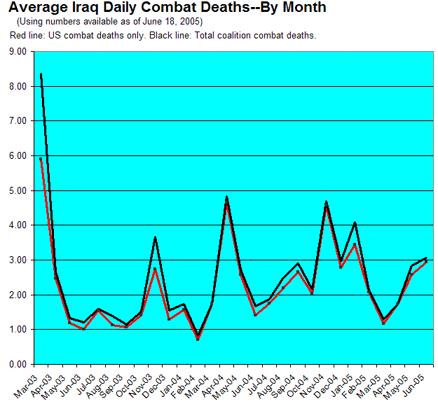
And here, for comparison purposes, is the most-recent version of my own graph of US combat deaths in Iraq:
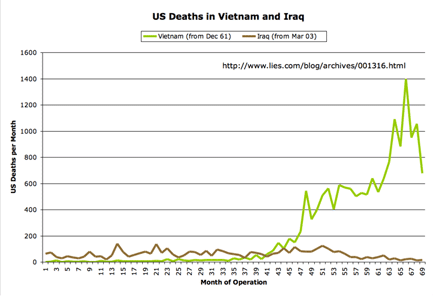
Esmay is using the same source for his data that I’ve been using for mine (the Iraq Coalition Casualties site), so it shouldn’t be surprising that the two graphs look similar. The one thing he’s doing differently with his numbers (besides avoiding my gratuitous comparison with Vietnam) is that he’s not plotting total deaths per calendar month, the way I am, but is instead giving a month-by-month daily average. (Oh, and he’s listing US and total coalition deaths as separate lines, while I do only US deaths; and he’s looking at combat deaths only, while I include non-combat fatalities. And he’s got that pretty blue background going on.)
Now, in one sense his use of a per-day average is misleading, in that it somewhat obscures the actual number of deaths involved. Glancing at his graph, you don’t see a monthly total of deaths ticking by (36, 52, 80…). Instead you see the less-alarming daily average (1.29, 1.73, 2.84…). And of course you could do the math yourself to figure out the actual number of deaths, but his labelling of the graph’s y axis makes those numbers just a tad less obvious.
The other thing that this choice of Esmay’s does is to let his graph emphasize the higher death rate in the very early days of the war. That’s because the March, 2003 numbers that make up both his and my first plotted data points actually only cover 11 days of fighting, from March 21 to March 31.
Those early days of the war were relatively deadly. On March 23, 2003, for example, 30 US troops died, most of them as part of the intense fighting that took place in and around Nasiriyah. March 2003 also saw some helicopter crashes with multiple fatalities, some friendly-fire and non-hostile vehicle accidents, and generally just a very large amount of shooting and bombing and mayhem.
What does Esmay make of this?
Note that in this first chart, ever since what was called “Major Combat Operations” (or what should probably more appropriately be called “The Invasion”), mortality has been much lower overall. We’ve never had a period as high in the number killed as the initial invasion, although we’ve had a few pretty bad days here and there.
I guess what he means is that, generally speaking, we haven’t had as many people dying in as short a period of time as we did during those first 11 days of the war. But it seems fairly silly to me to compare the first 11 days with monthly averages since then, in order to derive some hopeful observation about how mortality has been “trending” downward. We have to be sure to speak “generally,” too, since if we speak more specifically, there have been at least a few times when we’ve had short-term mortality rates higher than that of the initial invasion. For example, there was early May, 2004, when 79 US troops died in 10 days (7.9 deaths per day). Or early November, 2004, when 89 US troops died in 10 days (8.9 deaths per day). And in general, I think we’d have to recognize that the 1670 US deaths since the end of March, 2003, are fairly significant when compared to the 65 deaths that came before, even if the average daily death rate, when averaged on a per-month basis, has tended to be lower than it was during the war’s first 11 days.
What most of us really want to know, of course, is what the overall trend has been. Are we “making progress”? Is the insurgency in “its last throes”? Or are we thrashing along at pretty much the same rate of US deaths each month, or in fact seeing a slight increase over time?
Dean has this to say on that key question:
Overall, if you try to plot a trend over the entire period starting from day 1, you see a very mild upward curve, but that doesn’t really make sense. There was no organized resistance per se until several months after the initial invasion and the fall of Baghdad, and the mission of occupying forces is completely different from the mission of invading forces.
I find this passage really remarkable. The “very mild upward curve” Esmay sees is simply the objective reality that the US Iraq war death rate, over the entire course of the war, has been trending gradually upward. We’ve already seen how Esmay went out of his way to come up with an initial graph that gave him a high first data point on which to hang his preferred interpretation (that the overall trend is downward), but now, when he actually tries to fit a curve to the numbers, he realizes that it goes the other way. So what does he do? He simply rejects reality, because it “doesn’t really make sense.”
Hm. Maybe if he pokes and prods at the numbers some more, he can come up with a picture that looks more like what he wants. And indeed, that’s what he does next: he takes the four “periods” discussed by the Iraq Coalition Casualties web site (the initial invasion to the end of major combat, the end of major combat to the handover of sovereignty, the handover of sovereignty to the Iraqi elections, and the time since then), and plots the average daily death count for each period as a whole:
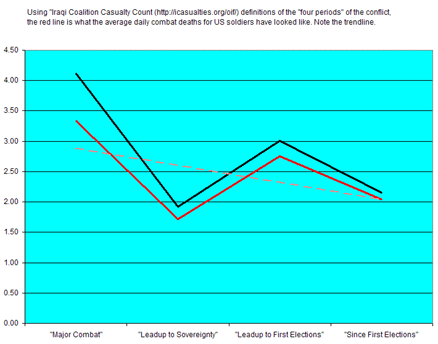
Now, this graph is really wacky, at least in the sense of providing any kind of apples-to-apples comparison. Note that we’re presenting four very different-sized chunks of time: The initial chunk covers about 2.3 months, the next one about 14 months, the next one about 7 months, and the last one about 4.7 months. This presentation completely obscures the overall death totals, since the periods across which the daily average is being computed can no longer be read from the graph.
But he gets what he’s really after: The downward “trend” (which again, he’s only able to get because he’s comparing the apples of the initial invasion to the oranges of the post-invasion occupation, over the course of which, even in this distorted presentation, you can see that the mortality is actually trending upward).
He concludes his analysis with the following:
My own gut tells me, frankly, that if by this time next summer the Iraqis do not have a new Constitution and have not held new elections that the formerly-privileged Sunni minority have participated in to a reasonable degree, it will probably be time to question whether the operation is ever going to succeed and start rethinking our strategy.
Until then, it seems obvious that we continue to retain the upper hand, and that the fascist insurgency is losing. Let’s hope that trend continues.
But as you can see, it’s really been his gut doing the talking all along. He ignores and massages the actual data as much as he needs to in order to make it support his a priori belief that we are, in fact, defeating the insurgency. But his own numbers clearly show that the insurgency has been getting stronger over time, rather than weaker (at least as measured by US deaths).
I’m reminded of the following graph by Dale Amon of Samizdata.net, which he hopefully presented under the headline “We are winning” back in October of 2003:
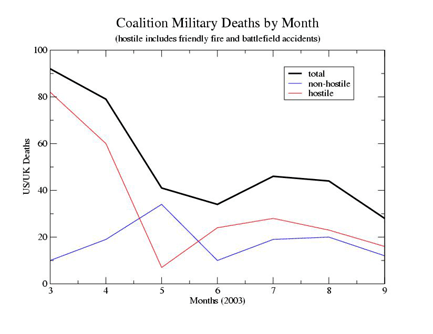
Amon was merely premature in deriving a negative trend from the insurgency’s slow start. I haven’t checked, but I doubt he’s updated that graph lately. Esmay, revisiting the same numbers today, needs to go to considerably greater lengths to find an upbeat message, but find it he does, in a nice example of how a hard-nosed, just-the-facts conservative (update: or not; see his response in the comments) can actually compete quite nicely with a mushy-headed liberal like me when it comes to ignoring data that conflicts with his worldview.
Update: As a sort of pretty-pictures-over-facts exclamation point, Esmay links at the end of his post to the following item from weblogger Chrenkoff: The willing. It features a nice collection of flags and soldiers in stirring martial poses, illustrating the “26 other countries… doing good work for the future of Iraq.” Yes, well, I wouldn’t want to call into question the individual courage of those 33 Macedonians and 26 Kazakhstanis, and the approximately 10 Norwegians currently in-theater are doing their part, I’m sure (amazingly, it looks like every single one of them managed to fit into Chrenkoff’s photo).
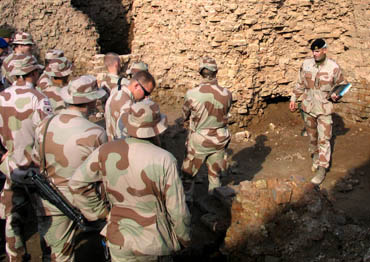
But if we’re going to talk about hard numbers, here’s the true picture: US forces currently account for about 87% of the foreign troops in Iraq. The next-largest contingent, from the UK, accounts for 5%. South Korea is 2%. The next three countries in descending order (Italy, Poland, and Ukraine) are 1.8%, 1.0%, and 0.8%, respectively — and all three of them are due to be gone before the end of the year. The manpower contributions of the other 20 countries in our grand coalition are significantly smaller than those. (See globalsecurity.org for details.)
I realize this leaves out the Iraqi forces we’ve been struggling to train and equip, and yes, I realize that they’re the ones we will eventually be handing this situation off to, one way or another, assuming any of them survive the insurgency’s targeted killings long enough for us to hand it off to them.
I’ve got nothing against giving all these brave soldiers their moment to pose, proud and unmaimed, under their country’s flag while someone snaps a photo. They deserve that.
Okay, we’ve now given them that. So let’s get back to talking realistically about what it’s going to take to get them out of this clusterfuck and back home.






